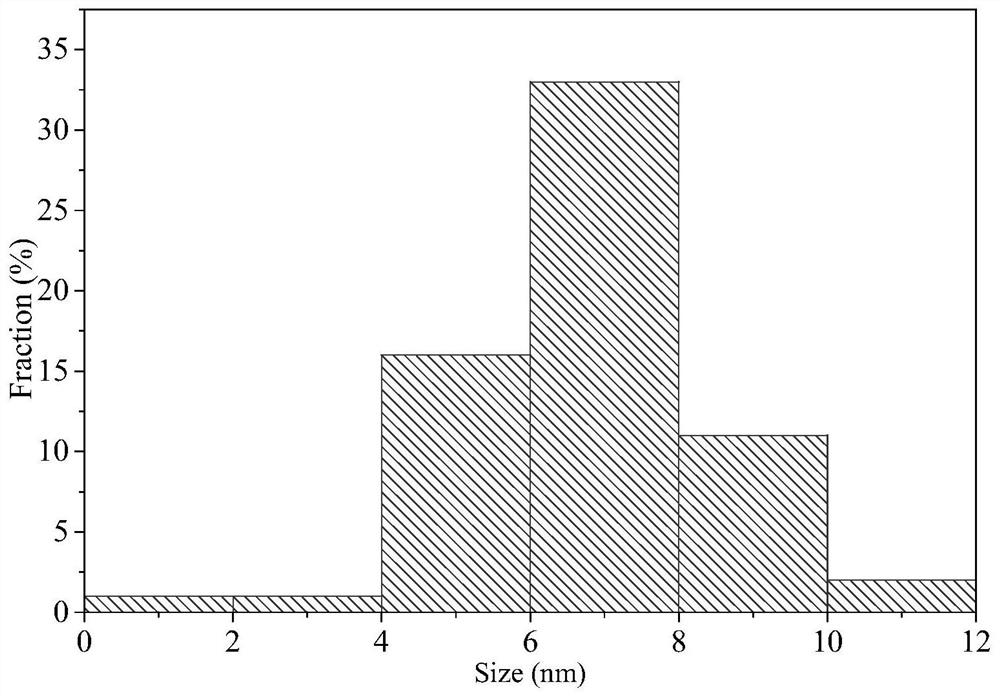Sulfydryl-modified cyan fluorescent carbon quantum dot and application thereof in rapid detection of arsenic ions in water
A technology of thiol modification and carbon quantum dots, applied in fluorescence/phosphorescence, nano-carbon, nano-optics, etc., can solve the problems of complex sample pretreatment, expensive equipment, low work efficiency, etc., and achieve good water solubility and detection limit low cost effect
- Summary
- Abstract
- Description
- Claims
- Application Information
AI Technical Summary
Problems solved by technology
Method used
Image
Examples
Embodiment 1
[0030] Take 3g tartaric acid and add it to 30mL deionized water, sonicate for 30 minutes; add 7.5g cysteine to 30mL deionized water, sonicate for 30 minutes; mix the two solutions evenly, and transfer them to the polytetrafluoroethylene in a 100mL hydrothermal kettle. In an ethylene liner, sealed, heated to 200°C, reacted for 10 hours, cooled to room temperature, transferred the product to a dialysis bag with a molecular weight cut-off of 2000, and dialyzed in deionized water for 24 hours; collected samples in the dialysis bag and frozen Dried to obtain a brown solid powder, namely thiol-modified cyan fluorescent carbon quantum dots. Depend on figure 1 It can be seen that the obtained solid powder has uniform size and good dispersibility. Depend on figure 2 It can be seen that the size distribution of the obtained solid powder is mainly concentrated between 4 and 7 nm. image 3 Middle 3400~3300cm -1 The moderately strong absorption peak corresponds to the N-H stretching...
Embodiment 2
[0032]Take 1.5g of tartaric acid and add it to 30mL deionized water, and sonicate for 30 minutes; add 7.5g of cysteine to 30mL of deionized water, and sonicate for 30 minutes; In a vinyl fluoride liner, sealed, heated to 200°C, reacted for 9 hours, cooled to room temperature, transferred the product to a dialysis bag with a molecular weight cut-off of 2000, and dialyzed in deionized water for 24 hours; collected samples in the dialysis bag, Freeze-dry to obtain a brown solid powder, that is, thiol-modified cyan fluorescent carbon quantum dots.
Embodiment 3
[0034] Take 3g tartaric acid and add it to 30mL deionized water, sonicate for 30 minutes; add 6.0g cysteine to 30mL deionized water, sonicate for 30 minutes; after mixing the two solutions evenly, transfer them to the polytetrafluoroethylene in a 100mL hydrothermal kettle. In an ethylene liner, sealed, heated to 200°C, reacted for 12 hours, cooled to room temperature, transferred the product to a dialysis bag with a molecular weight cut-off of 2000, and dialyzed in deionized water for 24 hours; collected samples in the dialysis bag and frozen Dried to obtain a brown solid powder, namely thiol-modified cyan fluorescent carbon quantum dots.
PUM
| Property | Measurement | Unit |
|---|---|---|
| size | aaaaa | aaaaa |
| concentration | aaaaa | aaaaa |
| concentration | aaaaa | aaaaa |
Abstract
Description
Claims
Application Information
 Login to View More
Login to View More - Generate Ideas
- Intellectual Property
- Life Sciences
- Materials
- Tech Scout
- Unparalleled Data Quality
- Higher Quality Content
- 60% Fewer Hallucinations
Browse by: Latest US Patents, China's latest patents, Technical Efficacy Thesaurus, Application Domain, Technology Topic, Popular Technical Reports.
© 2025 PatSnap. All rights reserved.Legal|Privacy policy|Modern Slavery Act Transparency Statement|Sitemap|About US| Contact US: help@patsnap.com



